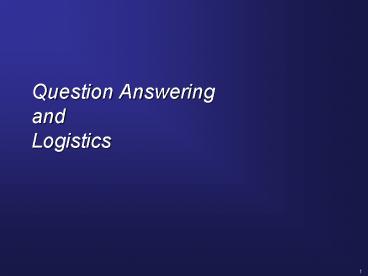Question Answering and Logistics - PowerPoint PPT Presentation
1 / 9
Title:
Question Answering and Logistics
Description:
Question Answering and Logistics – PowerPoint PPT presentation
Number of Views:25
Avg rating:3.0/5.0
Title: Question Answering and Logistics
1
Question AnsweringandLogistics
2
Class Logistics
- Comments on proposals will be returned next week
and may be available as early as Monday - Look at website for slides
- Grades on presentations and discussant questions
3
Next week 2/21
- Invited speaker John Prager, IBM
- Location 7th Floor Interschool Lab
- Class structure
- First half talk
- Second half discussion
- Discussants David Smith, Narayan
- Others raise questions
- This is your chance to find out the details of
how a system works
4
Using Knowledge-Based Constraints to Improve
Question-Answering Accuracy
- Most Question-Answering systems use a combination
of statistical and symbolic techniques for
example, almost all use a search component, which
fetches documents and/or passages using
statistical matching formulae, and answer
selection techniques which are often more
linguistically-informed. The QA system at IBM
Research, which has performed well in TREC-QA
over the years, is no different in those
respects, but we have at the same time been
exploring various knowledge-based filtering
chniques to constrain candidate answers. I will
describe three such techniques. The first, which
has been part of our core system since 1999, is
what we call Predictive Annotation, a form of
semantic indexing in which the answer type is a
required term in the search engine query, greatly
reducing the number of passages that need to be
considered. QA-by-Dossier asks additional
questions to the one from the user, and enforces
real-world constraints between the different
questions and answers, on the assumption that
only correct answers will provide a consistent
model. Finally, Question Inversion is a specific
form of QA-by-Dossier in which initial candidate
answers are inserted into a reformulated question
with a term removed, with the expectation that
only the correct answer will allow the removed
term to be recovered. I will present
experimental results from using these techniques,
and discuss their pros and cons.
5
Questions
- Kristen - Hermjaikob
- The reformulation technique described in
Hermjakob et al. require a person in the loop
to generalize phrase synonyms from
automatically-extracted patterns. These are
likely to be high-quality at the cost of being
low-coverage (420 assertions). - Some types of data are naturally suited to
knowledge bases, for example, dictionaries,
synonyms, lists of countries, etc. WordNet is an
example of a highly successful knowledge base
that is used a lot in NLP. Are phrasal
reformulations suitable for storing in a
knowledge base? ie, if we could expand their
system to contain a million assertions, would
this hand-crafted database be sufficient/useful? - These reformulations require the authors to
identify anchor-patterns that can be
reformulated only questions that match these
patterns can be expanded. What are good resources
for finding anchor patterns, ie, for finding
questions that users are likely to ask? (besides
prior TREC evaluations) - Can you think of ways that we could automatically
extract patterns like this? Or ways where the
human in the loop could do a lot less work?
6
Kristen - annotation
- All of the papers rely heavily on data
annotation, e.g., marking names, numbers,
syntactic parsing, dependency parsing, etc.
However, automatic annotation is never perfect.
(For example, the best named entity tagger gets
90-95 F-measure on English newswire, which is a
very good score, but this means that 1 out of
every 10-20 named entities is incorrectly
tagged!) - Can automatic annotation ever be perfect? What
implications does this have for higher-order NLP
processing, such as question answering? - What measures do these systems take to address
these problems?
7
Kristen and Mahav - Evaluation
- TREC has spurred a lot of research into question
answering over newswire, and created reusable
data for system comparison. - What are some of the downsides to having a
standardized bake-off with a shared
corpus/language/question type? If you worked for
a web search company, would you implement the
systems we've read about? - . Is the TREC evaluation methodology suitable?
Should the answer nuggets be constructed
independently of system outputs? What would you
do to evaluate a QA system?
8
Madhav Statistical vs. Symbolic
- 1. Moldovan et al. describe a heuristic based
answer extraction system whereas Ittycheriah et
al. use a statistically driven method. What are
the drawbacks and advantages of each? Would these
techniques, given the various heuristics (or
features) used, adapt to different domains?
Moldovan et al. claim that their system is
open-domain.
9
Madhav Complexity
- 3. Current QA systems seem to have to perform a
great deal of processing in order to fulfill the
task. When systems are as complex as this, and
are made-up of many sub-components, is it at all
possible (say, as a researcher) to pin-point the
"weak-link" within a system in order to improve
its performance? Can one evaluate the
sub-components independently? Is that necessary?
For instance, IBM used a dependency parser - do
you think that similar higher-level NLP
techniques would be more helpful in solving the
problem at hand? Or will lower level bag-of-words
(IR) techniques be more suitable?

